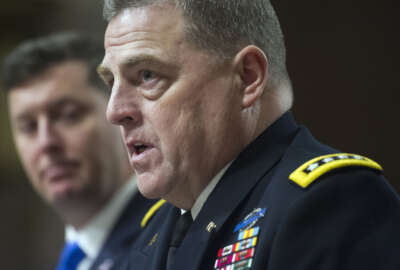The Chief of Staff of the Army says he’s pushing for a more mobile force of the future, both in terms of technology and acquisition.
At the Future of War Conference, sponsored by New America and Arizona State University, Gen. Mark Milley said he’d like to push for decentralization in the acquisition process.
“We’re trying to figure out ways to speed up the acquisition system. Some of these systems take multiple years – some of them decades – to develop, so the original requirement, by the time the thing is developed, the commercial sector or the technology’s already overcome the original requirement to begin with,” Milley said on March 10. “So you’ve got some issues in terms of flash to bang — how fast you deliver to market or deliver to the customer the system or the capability that was originally required to begin with.”
Rather than run decisions through a rigid chain of command, Milley said he’s like to see more agile acquisition that’s powered by putting the right people in charge of the right tasks.
“The best methods of management are to empower and decentralize. I think that I should be able to look at someone and say ‘Here’s your task, here’s why you’re doing it, here’ s the purpose, here’s the end-state that I want you to achieve, by such-and-such a time. Go forth and have at it. If you succeed, you’re promoted, and I give you a medal. If you fail, you’re fired.’ And you hold people accountable, what you don’t do – what large organizations do over and over again — is they observe things that are screwed up in the environment, and they take the problem and they centralize it, and they actually make it worse,” he said.
At the same time, Milley acknowledged that maneuverability comes with a degree of scrutiny from higher-ups at the Pentagon.
“It’s not a lack of oversight, I’m not asking to be ‘Hey, I’m free reign, let’s go party.’ I’m not saying that at all. I’m saying let me, and then hold me accountable. Let me figure out what type pistol we need, and then let me go buy it without having to go through nine years of incredible scrutiny and testing,” he said.
When it comes to the future of the Army’s forces Milley said advancements in robotics technology could change the character of ground combat through a more mobile delivery of materiel.
“I can envision a ground force sometime 10-15 years from now where a lot of your convoys — your resupply, your logistics, all that stuff where we expose soldiers to IEDs — that those are done by robots. Those vehicles are autonomous vehicles, you load them up with ammunition and chow and so on, you plug in the grids, and boom, off they go,” Milley said. “The domain of ground combat is fundamentally different than air or maritime, it’s not as clean… so the application of robots to ground, we’ve still got to work out all the problems.”
He went on to say the Army research is currently “on the cusp of some really significant material breakthroughs” in lightening up armor.
In terms of the future of military threats, Milley said the Army has four state-specific threats — Russia, China, North Korea, and Iran — and it’s ongoing counter-terrorism strategy.
“The challenge for us, the challenge for the Army and the military at-large, is we have got to sustain and maintain counter-insurgency and counter-terrorist capabilities. We can’t lose that which we gained and learned over the last 15 years…. We’re going to have to retain those capabilities, so as I look at how to size and structure the force, those capabilities are absolutely essential, because that fight’s going to continue, even if ISIS is destroyed.”
In mitigating those risks, Milley said the overall size of the force is just one component that leadership should consider.
“It’s really not size. I mean, the numbers of forces is only one factor. Readiness is actually the more important of the factors – the skills of the force, the leadership of the force, are those units that you have fully manned, are they fully trained, and so on. So size is only one piece, and then you want to make sure they they’ve got the right technology and equipment,” he said.
Copyright
© 2024 Federal News Network. All rights reserved. This website is not intended for users located within the European Economic Area.
